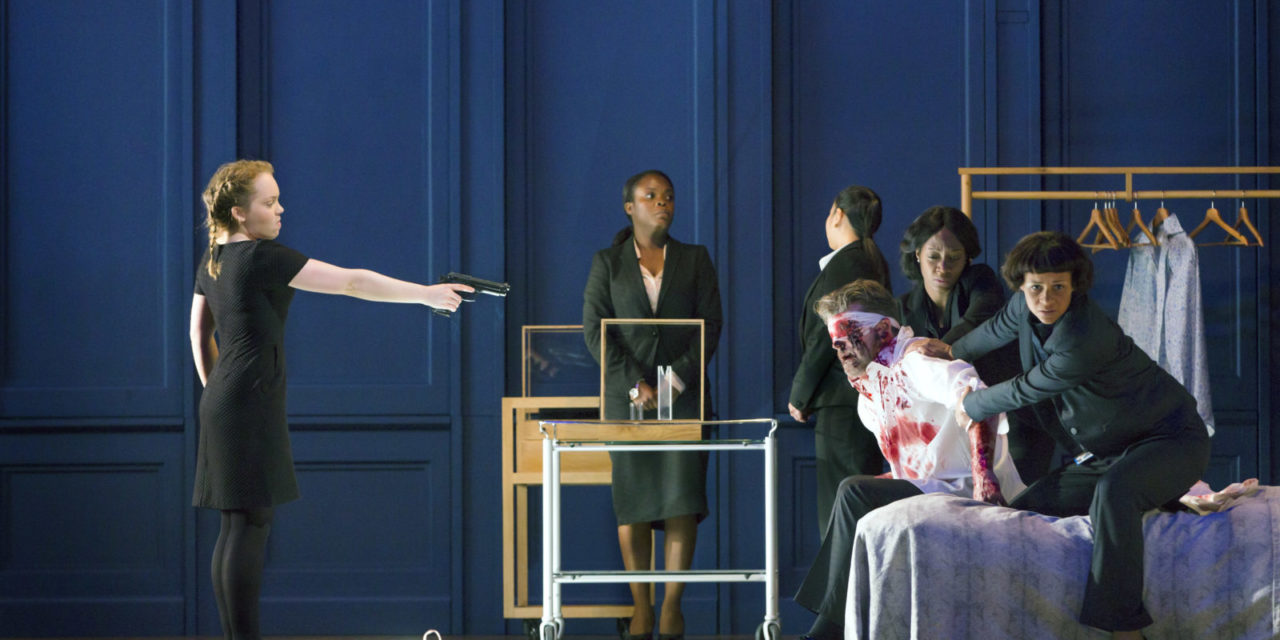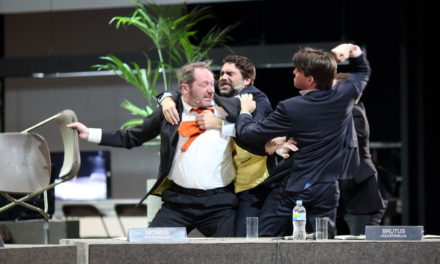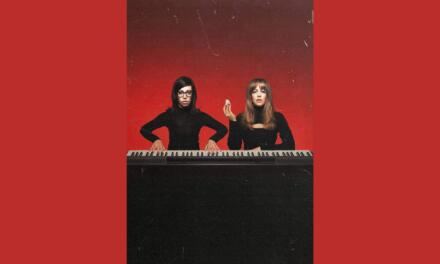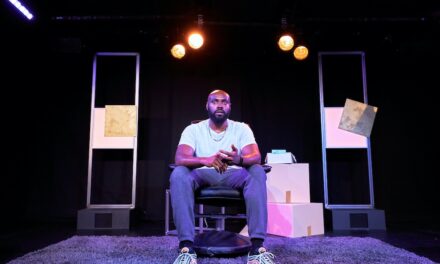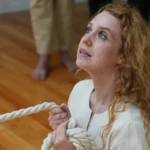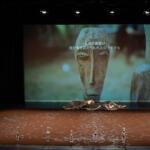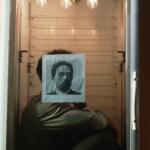The dramaturgy of love’s intertwining with violence has been a recurring theme in the operatic repertoire since its incarnation, from the lovers’ demise in Wagner’s Tristan und Isolde to the unspeakable murder of a child in Janaček’s Jenůfa. However, in the twenty-first century, this deadly concoction of heart and brutality hasn’t been more apparent than in the opera’s of George Benjamin, composer, and playwright Martin Crimp. Benjamin, whose music has delighted listeners for several years, only found his opera legs over a decade ago. The same can be said for Crimp. But perhaps it’s because of this that we can discriminate from the composer-led, hierarchical chain that opera has insinuated since Verdi or Puccini’s time. If the importance of the libretto isn’t something that grabs you right away – then known that the Lincoln Centre’s production of Into the Little Hill (2006) played without subtitling, a confident statement of how listening to the text becomes as important as listening to every note of music. It’s not since Benjamin/Crimp have I seen an acknowledged collaboration of two individuals that have, in short, created another exciting perspective on how to interpret the operatic form.
Benjamin, born in 1960 in London, would build on his love for French music from Debussy to Boulez, following his study of classical music in Paris with Oliver Messiaen. Since then, he would become one of the most distinguished composers and conductors that opera has known, with several compositions for the BBC Symphony Orchestra, the London Sinfonietta, and the Salzburg Festival. His admiration and determination for opera would bring him in contact with Martin Crimp in 2005. Crimp, who is one of the world’s most distinguished English-language playwrights, made his professional debut in 1982 at the Orange Tree Theatre, London with his play ‘Living Remains’. His work has been translated into many different languages and produced by the National Theatre, Royal Court, amongst others. It is with their unification that opera would see an exciting new voice reach global stages, one that harkens to a previous world of mythology and history but plays upon our perception of modernity through a frightening and unsettling familiar exterior. Benjamin was looking for a playwright to match his musical palette for a long time, and Crimp seemed the perfect fit.
With the hunger for an opera raging strong (in Benjamin in particular), the hunger would be fed through the composition of Into the Little Hill (2006). The lyrical tale in two parts, running at 40 minutes, was commissioned by the ‘Festival d’Automne’ in Paris, in a production directed by Daniel Jeanneteau. And with a legacy for mythology to become a recurring theme in their preceding works, it would come as no surprise that their source would be the myth of the Ratcatcher of Hamlin.
Benjamin and Crimp’s chamber opera follows the tale of a minister up for a re-election but will only win the vote of the people should he rid the town of the rat infestation. To win the respect of the people, and his own young daughter, the minister appoints a mysterious, faceless figure to rid the town of the rat plague, only to learn that in the chaotic bloodbath of politics, there is always a price that needs to be paid.
The standard saying for any dramatic writing is that content dictates form, and it’s evident that Benjamin and Crimp are prepared to declare their own incarnations of both. Whilst the Ratcatcher of Hamlin might not be the most obvious source for an operatic narrative, it does offer an alternative method for evoking mythology in contemporary form. And there’s that word – ‘form’. Whilst there exists a plethora of characters to tell the story, including the minister, his wife, their daughter, the stranger and the story’s narrator – it would be Benjamin’s own artistic choice to appoint only two voices for them all. As such, a soprano and contralto are the only voices on stage, voicing between them a dozen characters: and both of them female.
Now, the content seems clear, and with a distinct division in form, it is clear that both librettist and composer recognize the theatricality evoked in the story. We have Sarah Grochala to thank for theorizing the ‘narrative mode’ (2017) as a model for characters who represent the role of a chorus for their own narratives, almost as if the two characters in the opera know abundantly well that they are a device for theatrical intent. But the meta-theatricality is alive even in Benjamin’s score – with the composer himself stating that music is the bridge between the grotesque reality of the character’s situation and the theatrical illusion within which it is presented.
In an unusual turn, the creative team was all consulted and collaborated with even before a single note of the score was written. Already, we are seeing an unusual practice in the way the writing duo approach their construction. ‘Into the Little Hill’s numerous productions across the globe proved to be a first triumphant step for the pair and it is all owed to the way a pair (or in the case, two pairs) of fresh eyes can look upon the operatic form by doing away with what has been done before them, but also through allowing the histrionics of opera to sit on their shoulder.
Their second opera which would premiere in 2012, proved undoubtedly to be a remarkable turning point for the partnership. This incarnation would see them both delving into history once again to present a more non-conventional setting for a contemporary opera. The result was Written on Skin.
Crimp’s libretto drew from the legend of Catalan troubadour Guilhèm de Cabestanh and is set somewhere less recognizable – 13th century France, proving that a contemporary libretto doesn’t require a contemporary source or entry point. Although, ‘Written on Skin’s original production drew on the inherent meta-theatricality in order to present something so deeply sublime. That is, the world of the opera might be a previous one, but is written in such a way that the work recognizes it, something which I will elaborate on in a moment.
Without wanting to waste time rethinking a new synopsis for the piece, I will draw on Frederik Berntsen’s – someone who has summarized the sequence of events in a more than adequate state already: “The tale takes place in 13th century France (…) a cruel country squire, called The Protector, invites an artist into his castle to make an illuminated manuscript about him. The work must reflect the squire’s merciless exercise of power and the beauty of the world he has organized around him. But his young wife Agnes gradually becomes more and more fascinated by the artist and seduces him. The Protector then murders the artist and feeds his heart to his unfaithful wife” (Berntsen, 2018).
The 90-minute opera tempers with a haunting score that almost makes it like a horror. But it’s worth noting how Benjamin & Crimp become fascinated with more conventional theatrical devices to illuminate such a daring plot. Notably, a chorus of angels in suits recall the actions of the drama as a story to one another and to the audience: “The woman? Was married aged fourteen” (Crimp, 2012). But not without first reminding us that the descriptions of the consequences in actions are inherently contemporary, and a reminder that the details of their story are in fact set in the moment with us as spectators: “Cancel all flights from the international airport (…) erase the Saturday car park” (Crimp, 2012). Written on Skin gives a platform to both love and violence, but in the lesson that The Protector presents to his wife through a horrific act of violence, no compromise can be made for either.
Even the dénouement shows no sign of mercy or relentlessness. Once Agnès has declared unfaithfulness to her husband, then blood is shed. Opera has long been the face of unprecedented violence – one may think of Strauss’ Salome as a mere start. So, the feeding of the artists’ human heart should come as no surprising operatic technique. Even in the many reprises of this opera in productions across the world – this opera still has the power to shock, a staple of the Benjamin/Crimp trademark.
Written on Skin premiered at the renowned Aix-en-Provence Festival in June 2012, performed by the Mahler Chamber orchestra in a production directed by Katie Mitchell, the first of their productions to be helmed by the internationally-renowned director known for her provocative and radical stagings. The opera became the first real victory for the partnership. The poetry of the third-person libretto even gestures on a more complex level than we are dealing here more than just a sung text, but a new strategy in which opera as a form can compliment a narrative as urgent, daring and unsettling as any other medium. In ‘Written on Skin’, there is an awareness of two world’s – the theatrical world and its current counterpart, and it’s through this gesture that we can hear the statement loud and clear: opera is just as urgent and valid now.
It would be six years until their collaboration continued on the Royal Opera House production of Lessons in Love and Violence (2018). This third opera in their personal repertoire would prove that both text and composition equally compliment each other, and that intimacy in setting (set in the traditional one-room vernacular) would blast the exoticism of opera between the four walls of the decor and back again in between the air of the performers and spectator.
Drawing once again from history, their inspiration would come from Christopher Marlowe’s rarely-performed play Edward II (1594), proving that urgency and relevance within a historical setting discard any weight to the term ‘outdated.’ In the opera, a King is forced to retire his crown following acts of neglect on his kingdom and dependency on a male lover. Having lost the faith and trust of his wife and children, Mortimer – the king’s confidant – passes the crown to the King’s son, but in an act of redemption through the affection and respect for his father, the young boy turns the seat of power by performing an unspeakable act of violence on Mortimer as part of a public entertainment.
To say that this is an opera that focuses on the forbiddance of love between two men would be misguided. In fact, it is better to draw from the Holland Festival’s show notes: “In their new opera, the composer and librettist probe the question of whether there is space for human love and affection at the heart of power.” In fact, the seats and status of power turn as if on a turntable with relentlessness. Both the King and Mortimer alternate between the perpetrator and victimized so much that it is uncertain who the spectator should empathize with. Yet, it is Mortimer who is banished from the Kingdom, and then it is him who restores political stability. The King is imprisoned for his choice to serve a personal lust over political responsibility, but it shouldn’t be forgotten that it was his neglect for the poverty of the people that placed him in that unfortunate position. Isabel, now the pawn between the two rogues seems more interested in those who give her more stability than obedience to the King. Perhaps the spectator would be wiser to remember how Crimp believes that there are no ‘lessons’ for the audience, but lessons for the characters – ones certainly needed for a collective so wrought with a multitude of contradictions and priorities.
Can love exist within the confines of power? The Boy, having watched with his sister like a classic Greek chorus as his parents disband the kingdom around them, shows no compassion for Mortimer. In the same vein as Written on Skin, it’s love or power, not both. And at the cost of power over love, the lessons of violence are introduced. The Oedipus-like technique is employed, and Mortimer is ushered into the room having had his eyes cut out. But as with all three of Benjamin and Crimp’s operas, violence manifests as a multitude of concepts. The most fatal act of violence that can be inflicted in their work is that of a broken heart, one that certainly any spectator can understand even slightly.
Katie Mitchell was brought once again to the helm as director and, even in the early stages of writing, was an integral part to the final production. One sees the devastation of the action through her choral placing of the young children, in the stylistic slowing-down of the action around central characters (that is, the slow-motion technique of the world around the soloists), and the constant hand of Isabel (played in the original production by Canadian-born Barbara Hannigan) always holding a spirit or drink of some sort. With the multi-perspective of one room, designed by Vicki Mortimer, the intimacy of the drama is not only seen through a ‘peep-hole’ but through the very active fly on the wall of the intimate, private space made public.
If there is one theme that draws together a thematic pattern in Benjamin/Crimp’s work, it’s their ability to revitalize a mythology in the contemporary age. Berntsen, on the creation of ‘Written on Skin’ states that: “Benjamin’s challenge was to make an opera seem natural in the 21st Century, to create a work that captivated people, to make them enter a different world.” The concepts of a different world are, of course, applicable to all the works despite the fact we know that each is touched by the same Gothicism and alarming recognisability in each. If, as David Levin tells us, opera is the art of balancing the unsettledness of a particular topic, then this is what doesn’t make of these operas seem natural now. To put it bluntly, I would contest that the unification of both Benjamin and Crimp ushered a classicism in the rituality of opera to the contemporary stage, but framed in the knowledge that they would execute it in their own natural voice and not by any other person’s definition.
Now, not to make any concrete claims or statements may seem unwise. But this is a personal analysis after all. The question that I would like to leave is whether it is the work of these writers is revitalizing the way we look at opera as we know it. If the wake of musical theatre has taught us anything in the twentieth century, it’s that musical partnerships are best left unbroken, like some sustained marriage that experiences its ups and downs. It’s in the non-hierarchical relationship of composer-librettist seen in Benjamin/Crimp that, in this writer’s opinion, that can see a shift in the way that views the innovation of new operatic works. What’s certain in all three operas is that Benjamin’s score and Crimp’s libretto color and enriches the other. Perhaps it’s the other reason that a photograph of them both opens the programme book to the Dutch National Opera’s reprise of Lessons in Love and Violence. It’s a frame that they both share.
This post was written by the author in their personal capacity.The opinions expressed in this article are the author’s own and do not reflect the view of The Theatre Times, their staff or collaborators.
This post was written by Christopher Harris.
The views expressed here belong to the author and do not necessarily reflect our views and opinions.

